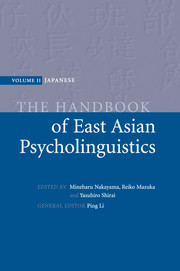Book contents
- Frontmatter
- Contents
- List of figures
- List of contributors
- In memory of Miwa Nishimura
- Preface
- Introduction
- Language acquisition
- 1 Ontogeny of language
- 2 Caregivers' speech
- 3 The intrinsic link between gesture and speech at the prelinguistic stage
- 4 Infant speech perception
- 5 Phonological acquisition
- 6 The mechanism of lexical development: implications from Japanese children's word learning
- 7 The acquisition of nouns and verbs in Japanese
- 8 The acquisition of verbal nouns
- 9 The acquisition of Japanese numeral classifiers
- 10 The acquisition of case markers
- 11 The acquisition of tense and aspect
- 12 On the origin of children's errors: the case of Japanese negation and direct passive
- 13 Binding Theory in UG and first-language acquisition of Japanese
- 14 The acquisition of the particles ne, yo, and no
- 15 The acquisition of linguistic politeness in Japanese
- 16 Children's narrative structures
- 17 Memory talk and testimony in children
- 18 Developmental dyslexia
- 19 Japanese Sign Language
- 20 The role of an innate acquisition device in second-language acquisition
- 21 Japanese, the grammar of reflexives, and second-language acquisition
- 22 Processes in L2 Japanese sentence production
- 23 The development of lexical competence among second-language readers
- 24 Reading in Japanese as a second language
- 25 Intrasentential code-switching in Japanese and English
- Part II Language processing
- References
- Name index
- Subject index
12 - On the origin of children's errors: the case of Japanese negation and direct passive
from Language acquisition
Published online by Cambridge University Press: 05 June 2012
- Frontmatter
- Contents
- List of figures
- List of contributors
- In memory of Miwa Nishimura
- Preface
- Introduction
- Language acquisition
- 1 Ontogeny of language
- 2 Caregivers' speech
- 3 The intrinsic link between gesture and speech at the prelinguistic stage
- 4 Infant speech perception
- 5 Phonological acquisition
- 6 The mechanism of lexical development: implications from Japanese children's word learning
- 7 The acquisition of nouns and verbs in Japanese
- 8 The acquisition of verbal nouns
- 9 The acquisition of Japanese numeral classifiers
- 10 The acquisition of case markers
- 11 The acquisition of tense and aspect
- 12 On the origin of children's errors: the case of Japanese negation and direct passive
- 13 Binding Theory in UG and first-language acquisition of Japanese
- 14 The acquisition of the particles ne, yo, and no
- 15 The acquisition of linguistic politeness in Japanese
- 16 Children's narrative structures
- 17 Memory talk and testimony in children
- 18 Developmental dyslexia
- 19 Japanese Sign Language
- 20 The role of an innate acquisition device in second-language acquisition
- 21 Japanese, the grammar of reflexives, and second-language acquisition
- 22 Processes in L2 Japanese sentence production
- 23 The development of lexical competence among second-language readers
- 24 Reading in Japanese as a second language
- 25 Intrasentential code-switching in Japanese and English
- Part II Language processing
- References
- Name index
- Subject index
Summary
Introduction
In the generative linguistics literature, there are numerous findings that support the view that an innate linguistic capacity (Universal Grammar (UG), Chomsky, 1965, 1981, etc.) plays a role in guiding first language acquisition by human beings. However, not much is known about whether UG is active from the beginning of development or whether it matures at a certain point in development. Thus, whether UG remains constant in child development remains to be investigated. To put this in the terminology of psycholinguistics, there is an issue of whether continuity (Pinker, 1984; Hyams, 1986) holds for UG in language development or whether some part of UG undergoes maturation in accordance with a genetically determined developmental schedule (Borer & Wexler, 1987, 1992). If continuity holds, UG remains constant in language development, and no part of UG undergoes maturation. As the null hypothesis, continuity seems to have a conceptual advantage over maturation. However, empirical assessment is necessary in arguing for either continuity or maturation. In this chapter, we discuss two syntactic constructions in Japanese, negative clauses and direct passives, paying special attention to their innate properties. For each construction, we evaluate data from child Japanese in order to determine empirically whether continuity in language development holds for the innate properties under consideration.
To assess the status of UG in language development, special attention is paid to children's grammatical errors. Children's errors deviate from the grammar of the target language to be acquired.
- Type
- Chapter
- Information
- The Handbook of East Asian Psycholinguistics , pp. 89 - 97Publisher: Cambridge University PressPrint publication year: 2006



